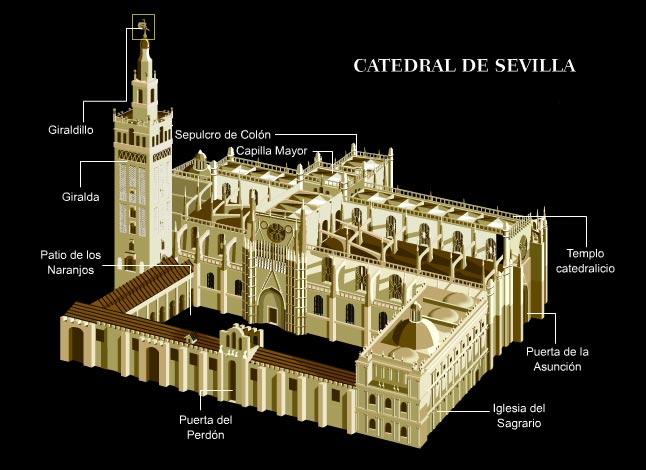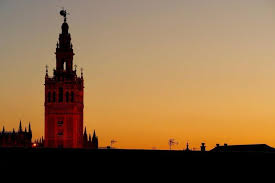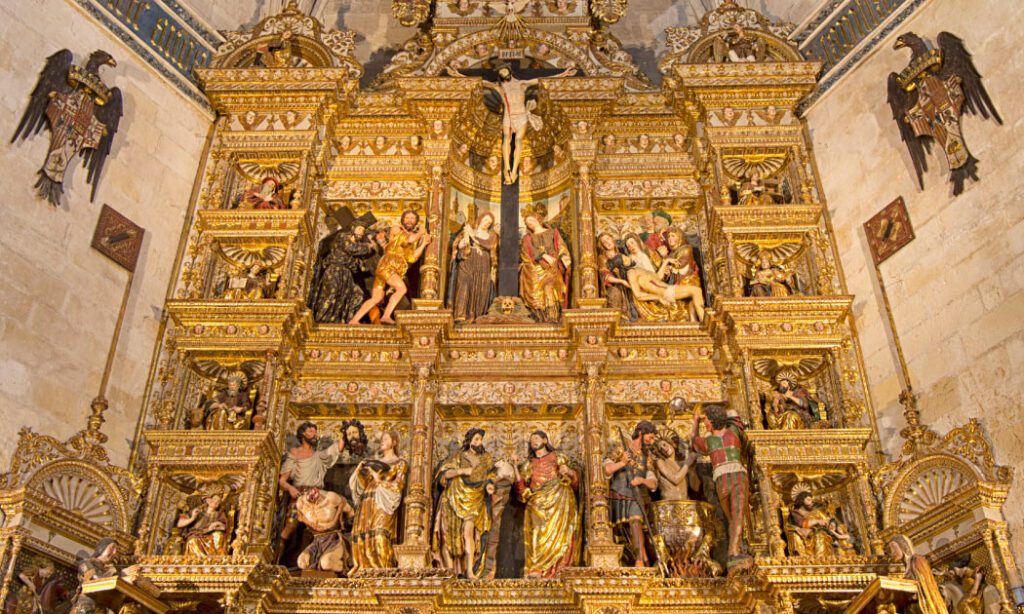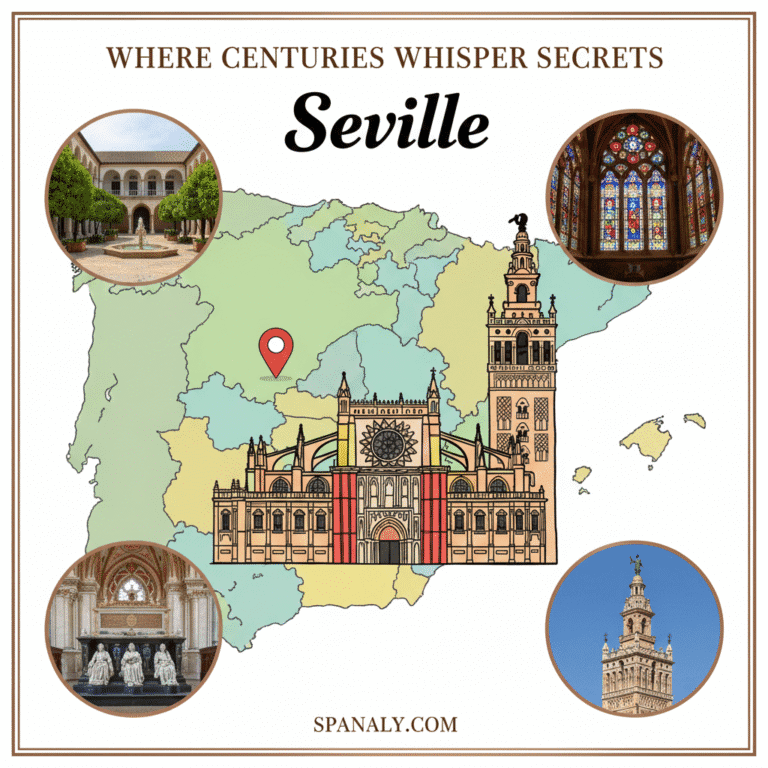At the heart of Seville, two of Spain’s most iconic monuments rise above the city skyline — the Seville Cathedral (Catedral de Santa María de la Sede) and its magnificent Giralda Tower. Together, they form one of Europe’s most extraordinary architectural ensembles, a place where faith, art, and history intertwine.
Declared a UNESCO World Heritage Site in 1987, this monumental complex is a must-visit for anyone exploring Andalusia.
Table of Contents
Toggle🕰️ A Journey Through Time: From Mosque to Cathedral
The site’s story begins in the 12th century, during Seville’s Moorish period, when the Almohad Caliphate built a grand mosque on this very ground.
When the city was reconquered by King Ferdinand III of Castile in 1248, the mosque was consecrated as a Christian church.
However, by 1401, the city’s leaders envisioned something far grander — a Gothic masterpiece that would reflect Seville’s growing power and wealth.
According to historical records, the cathedral chapter declared:
“Let us build a church so beautiful and so grand that those who see it finished will think we were mad.”
Construction lasted for over a century, resulting in the largest Gothic cathedral in the world — an achievement that continues to astonish visitors to this day.
🏗️ Architecture: A Blend of Cultures and Centuries

Seville Cathedral is a striking example of Late Gothic architecture, infused with Renaissance, Baroque, and even Islamic influences. The building covers an area of over 11,500 square meters, with ceilings soaring up to 42 meters high in the central nave.
Key Architectural Elements
The Gothic Nave: The cathedral’s interior is monumental — five naves divided by tall pointed arches, filled with natural light filtered through exquisite stained-glass windows.
Renaissance Chapter House: Built in the 16th century, it showcases perfect geometric harmony and domed ceilings.
Sacristy of the Chalices: A treasure chamber filled with sacred vessels and paintings by Murillo, Zurbarán, and Goya.
Baroque Additions: Over the centuries, several chapels and decorative elements were added, each reflecting the evolving artistic styles of Spain.
🔔 The Giralda: Seville’s Tower of Light

The Giralda Tower, standing 104 meters tall, is one of the most recognizable symbols of Spain. Originally the minaret of the 12th-century mosque, it was modeled after the Koutoubia Mosque in Marrakesh.
When the cathedral was built, the tower was preserved and crowned with a Renaissance belfry and a bronze statue known as El Giraldillo, representing Faith — from which the tower gets its modern name.
Climbing La Giralda
Unlike most towers, La Giralda is not climbed by stairs but by 35 gently sloping ramps wide enough for a horse to ascend — a remnant of its Islamic origins.
At the top, visitors are rewarded with panoramic views of Seville’s old town, the Alcázar, and the Guadalquivir River.
🎨 Artistic and Cultural Treasures
Seville Cathedral is more than an architectural wonder — it is a museum of faith and art.
The Main Altar (Retablo Mayor)
A colossal altarpiece 20 meters high and 23 meters wide, it took nearly 80 years to complete. Covered in gold leaf, it depicts 45 scenes from the life of Christ, making it the largest Gothic altarpiece in the world.
Christopher Columbus’ Tomb
Perhaps the cathedral’s most famous monument, this tomb contains the remains of the legendary explorer. Four heraldic figures, symbolizing the kingdoms of Castile, León, Aragon, and Navarre, carry the casket aloft — a fitting tribute to Spain’s maritime legacy.
The Choir and Organ
Intricately carved wooden stalls and one of the largest pipe organs in Spain make the choir an unmissable highlight for lovers of sacred music and craftsmanship.
The Patio de los Naranjos
Once the mosque’s ablution courtyard, this orange tree garden remains a tranquil oasis within the complex — a place to pause and reflect before entering the vast cathedral.

🧭 Visitor Information
📍 Address: Av. de la Constitución, s/n, 41004 Sevilla, Spain
⏰ Opening Hours:
Monday to Saturday: 10:45 AM – 5:00 PM
Sunday: 2:30 PM – 6:00 PM
(Hours may vary by season and religious events.)
🎟️ Ticket Prices:
General admission: €12
Students/Seniors: €7
Children under 13: Free
Includes entry to Cathedral, La Giralda, and Patio de los Naranjos
🖥️ Official Booking: https://www.catedraldesevilla.es/
🕊️ Best Time to Visit
The cathedral is open year-round, but your experience will vary depending on the season:
Spring (March–May): Ideal weather and the famous Semana Santa (Holy Week) processions fill Seville with tradition and emotion.
Autumn (September–November): Pleasant temperatures and fewer tourists.
Summer (June–August): Very hot (often over 40°C) — visit early morning or late afternoon.
Winter (December–February): Mild and quiet, perfect for photography.
🧭 Insider Travel Tips
Arrive early to avoid queues, especially for La Giralda climb.
Dress modestly, as the cathedral is still an active place of worship.
Download the official audio guide (available via QR code at the entrance).
Photography is allowed without flash; tripods are prohibited.
Combine your visit with nearby landmarks:
Real Alcázar of Seville (5-minute walk)
Archivo de Indias (next door)
Barrio Santa Cruz, the city’s most atmospheric quarter.
📚 Historical Curiosities
The cathedral’s bell tower was once the tallest building in the world.
Over 80 chapels fill the interior — it’s said that attending a mass in each would take more than a year.
The Giralda’s bronze statue, El Giraldillo, is over 4 meters tall and weighs nearly 1,000 kilograms.
Seville Cathedral is the third-largest church in the world, after St. Peter’s in Rome and St. Paul’s in London.
🍷 What to Do After Your Visit
Enjoy a drink at a rooftop bar near Plaza Virgen de los Reyes, overlooking the Giralda.
Try local specialties like salmorejo or tapas de jamón ibérico in Barrio Santa Cruz.
Visit the Archivo de Indias, housing documents from Spain’s colonial era.
Take a horse-drawn carriage ride around the historic center for a romantic touch
✍️ Final Thoughts
Visiting Seville Cathedral and La Giralda is not just sightseeing — it’s an immersion into centuries of devotion, artistry, and ambition.
From its Islamic origins to its Gothic grandeur, this landmark tells the story of Spain’s evolving identity and enduring spirit.
Whether you climb the tower for its breathtaking views or stand in awe before the golden altar, you’ll understand why this place is considered the heart and soul of Sev

